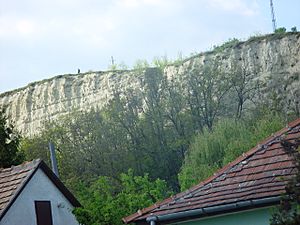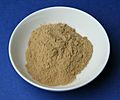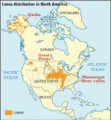Loess facts for kids
Loess (say "luss") is a special kind of soil. It's made of very fine, powdery dirt that has been carried by the wind. Think of it like super-fine dust! This dust often comes from places where glaciers used to be. When glaciers move, they grind rocks into tiny pieces, like flour. This "rock flour" then dries out and can be easily picked up by the wind. When the wind drops this dust, it can build up into very thick layers, sometimes hundreds of feet deep! You can find these deep layers in places like China and the central USA.
Contents
Loess: Wind-Blown Soil
Loess is a type of soil that is "unconsolidated." This means it's loose and not stuck together like solid rock. It's made of tiny, angular pieces of minerals like quartz, feldspar, and mica. Because these grains are not smooth and round, loess can often stand up in steep banks without falling apart. This is called "vertical cleavage." This special feature means people in some parts of China have even dug homes right into loess cliffs!
Where is Loess Found?
Loess is found all over the world. For example, Hungary has many areas covered by loess. You can see tall loess walls, sometimes called "reefs," in places like Dunaújváros. The central part of Belgium in Europe also has very thick layers of loess. Scientists have even found ancient tools made by Neanderthals in the soil layers between loess deposits in Belgium.
Why is Loess Special?
Even though loess can stand in steep banks, it's also very easy for water or wind to wash away. This means that areas with loess soil can sometimes be very dry. However, as the tiny mineral grains in loess slowly break down over time, they release important nutrients. This makes soils that come from loess usually very rich and good for farming.
Images for kids
-
Loess in Vicksburg, Mississippi, United States
-
An outcrop of loess in Patagonia
See also
 In Spanish: Loess para niños
In Spanish: Loess para niños








